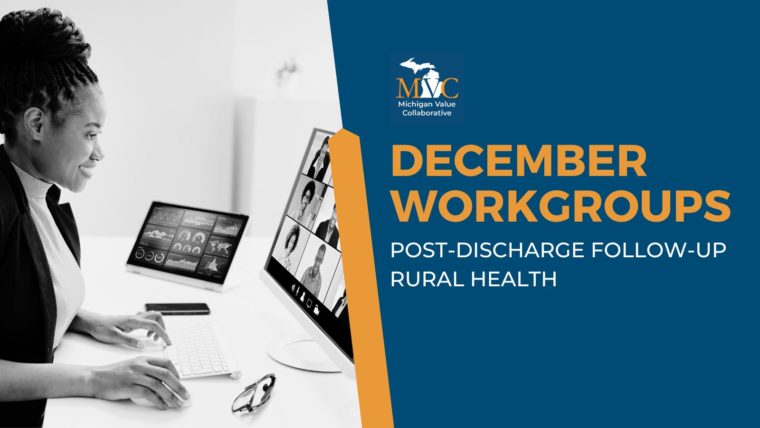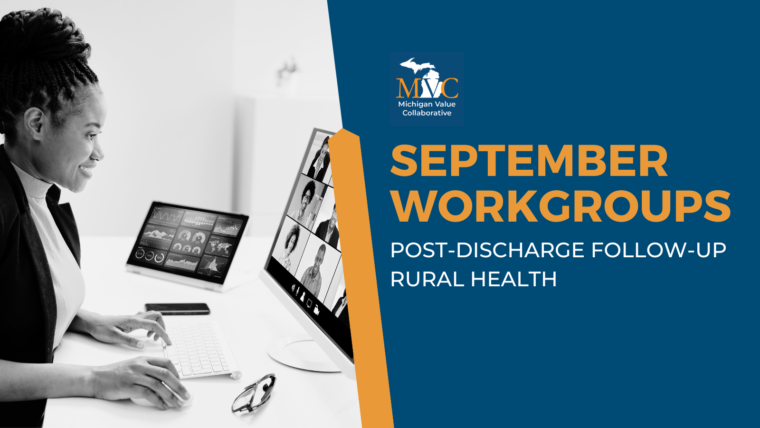In December, MVC hosted two virtual workgroup presentations – the first a post-discharge follow-up workgroup focused on end-of-life care, and a rural health workgroup focused on emergency department (ED) throughput quality improvement processes. MVC hosts two virtual workgroups per month with topics rotating between post-discharge follow-up, sepsis, cardiac rehabilitation, rural health, preoperative testing, and health in action (ad hoc focused topics). Each month, the MVC Coordinating Center publishes key highlights from the past month’s presentations to support resource and best practice sharing across the state.
Post-Discharge Follow-Up Workgroup December 3, 2024
The first workgroup of December focused on post-discharge follow-up and end-of-life care choices supported by Michigan Physician Orders for Scope of Treatment (MI-POST) legal documentation. This workgroup featured a presentation by Crystal Young, a Quality, Safety, & Experience Program Manager at Corewell Health, and Natalie Holland, Senior Advisor with the Michigan Department of Health & Human Services (MDHHS) Strategic Alignment and Engagement Team. The presentation reviewed Michigan’s MI-POST legal and healthcare guidelines, detailing options patients have when they are eligible for end-of-life services and care options.
MI-POST is an option for patients in their advance care planning (ACP) process. The ACP process includes discussing patient wishes for care, deciding how they want their needs met if they are unable to communicate, and documenting these decisions so that they are accessible for healthcare professionals when the patient is unable to speak for themselves. The presenters identified several ACP documents available in Michigan such as Durable Power of Attorney for Healthcare, Living Will, and Medical Orders such as the MI-POST and Out-of-Hospital Do-Not-Resuscitate Order (OOH-DNR).
The presenters described the history behind MI-POST as a portable medical order, starting as a pilot program in several Michigan counties in 2011 and then established through legislation and utilized across the state. This standardized form allows adult patients who require end-of-life services to establish specific guidelines for care in their last year of life. The presenters detailed the sections and fields included within the form, which can be found on the Michigan Department of Health and Human Services website. The presenters explained that the MI-POST form must be updated each year and has some similarities and differences to other ACP documents. Below is a table provided by the presenters comparing the MI-POST document to the other forms of ACP (Table 1).
The presenters shared that one benefit of completing the MI-POST form is that a witness is not required to be present for the patient to sign the document; however, it does require the signature of a physician or other advanced practice provider. Furthermore, they said, since MI-POST is a portable medical order, it travels with the patient and details the level of emergency response the patient prefers and can be used to guide care in any setting.
MVC Post-Discharge Follow-Up Workgroup Dec. 3, 2024
Rural Health Workgroup December 12, 2024
On Dec. 12, MVC hosted its final rural health workgroup of 2024. Toni Moriarty-Smith, RN, MSN, Director of Quality and Clinical Risk at McLaren Northern Michigan Hospital, presented on their emergency department (ED) throughput quality improvement process.
Moriarty-Smith commented that many of the challenges faced by rural hospitals after the COVID-19 pandemic are still being dealt with today. McLaren Northern Michigan found that after the pandemic lifted, their ED experienced a significant uptick in patient volume and patient acuity, with increased wait times in the ED and patients leaving without being seen by a physician.
Moriarty-Smith said several factors played a part in the increased wait times and ED overcrowding at McLaren Northern Michigan. In addition to regular inpatient boarders, there were lengthy bed holds for skilled nursing patients because facilities were limiting admissions with selective criteria, behavioral health patients (especially pediatric) were being held longer in ED beds, and beds were being held for outside facility direct admits.
In addition to the influx of patients, she said, the hospital experienced an unprecedented reduction in staff (approximately 50%) either from retirements or resignations post-pandemic. This directly impacted the efficiency of moving patients through the ED in a timely manner. McLaren Northern Michigan completed root cause analyses to begin pinpointing areas of opportunity for improvement. After completing a review of current literature, Moriarty-Smith said hospital leadership identified multiple strategies to address their challenges.
One of the first adjustments made was implementation of a fast-track triage process with ED physicians and advanced practice providers working in the triage area. The fast-track triage process was triggered when all registered nurses (RNs) were in full assignment, a triage RN or other support staff were able to start protocol orders, and an ED provider was available to work in triage. Figure 1 below shows the Median ED throughput for patients from arriving to the ED to discharge before and after the fast-track process was implemented.
Prior to the implementation of this new triage process, McLaren Northern Michigan struggled to complete timely blood draws. Due to diminished staffing the hospital was pulling nurses from the ED or from the floor to help do lab draws in the ED. This slowed the triage process and affected other areas within the hospital. In response, they developed a strategy to reduce the load on nurses by cross training patient care techs (PCTs) to do lab draws, offering a more senior position with increased pay to improve efficiency and processing.
McLaren Northern Michigan also worked in collaboration with their family advisory committee to establish a volunteer presence in the ED. These volunteers helped educate and inform patients about what to expect coming into the ED, provided warm blankets and words of encouragement, and generally supported those waiting to be seen. The extra care and attention helped patients feel seen and listened to and improved their experience (Figure 2). The addition of volunteers also helped reduce the number of patients who left without being seen (Figure 3).
Moriarty-Smith said they also sought to address issues related to staff recruitment. McLaren Northern Michigan raised the base pay of all RNs, transitioned contracted RNs to temporary status (approximately 70%), implemented a recruiting initiative to re-hire past employees, and expanded traveling provider contracts to open more beds for ED boarding patients.
The improvement measures McLaren Northern Michigan implemented have had an overall positive impact on the hospital. Over the course of her presentation, the challenges shared by Moriarty-Smith resonated with other attendees and inspired robust discussion about strategies being implemented across the state to address barriers to QI.
MVC Rural Health Workgroup Dec. 12, 2024
MVC looks forward to continuing to host two virtual workgroups per month in 2025. To view the 2025 schedule of events with registration links, view the 2025 calendar on MVC’s events page [LINK]. If you are interested in leveraging MVC’s robust registry of claims data and data specialists to inform a local or system-level quality improvement effort, reach out to the MVC Coordinating Center [EMAIL].






